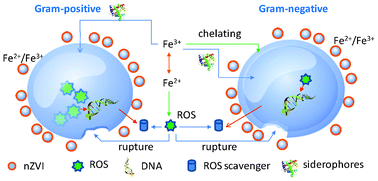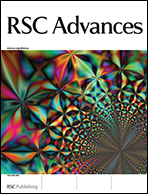This study investigated the biological responses of Gram-positive and Gram-negative bacteria to nZVI particles, Fe2+ and Fe3+ ions. Two Gram-positive bacteria (Bacillus subtilis var. niger and Staphylococcus aureus) and two Gram-negative bacteria (Pseudomonas fluorescens and Escherichia coli) were subjected to treatment with nZVI particles (0.56 mg mL−1 = 0.01 mol Fe/L), Fe2+ (0.01 mol L−1) and Fe3+ (0.01 mol L−1) as well as their combinations with various volumes (10-1000 μL) under aerobic conditions. The iron and microbial mixtures were also subjected to magnetic separation, viability tests by BacLight kit and surface chemistry analysis by X-ray photoelectron microscopy (XPS). The inactivation was determined using an agar plate CFU counting method, and intracellular reactive oxygen species (ROS) was also measured. The experimental results revealed that Fe2+ and Fe3+ had stronger inactivation effects on all bacteria tested than nZVI under the experimental conditions; this effect was especially pronounced for E. coli. For nZVI particles of 0.56 mg mL−1, the bacterial growth was promoted when increasing volume was added, more significantly for S. aureus. In general, the culturing and viability tests showed that Fe2+ had stronger inactivation effects on Gram-negative bacteria, while Fe3+ inactivated more Gram-positive ones. However, the inactivation of the iron combinations was shown to vary greatly with bacterial types. ROS data showed inactivations of bacterial cells could also have resulted from in vivo damage by increased intracellular ROS levels. High magnetic removal efficiencies were observed for bacteria under the conditions tested, except for Gram-positive ones mixed with nZVI particles followed by addition of Fe3+. XPS data showed strikingly different surface chemistry for nZVI particles after reacting with B. subtilis and E. coli, and a more stable form of iron was produced for E. coli. The results from this study implied that the microbial inactivation by nZVI primarily results from Fe2+ and Fe3+ on the particle surface. Depending on their concentration levels, different reactive oxygen species (ROS) combat and survival mechanisms might be initiated by different bacterial types including production of metalloregulatory proteins and ROS scavengers. On the other hand, our study implies that living organisms could actively neutralize environmental oxidative stress.

You have access to this article
 Please wait while we load your content...
Something went wrong. Try again?
Please wait while we load your content...
Something went wrong. Try again?


 Please wait while we load your content...
Please wait while we load your content...